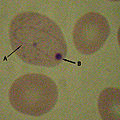Cabot rings
Cabot Rings are thin, thread-like inclusions found in the red blood cells. They are named after the American physician Richard Clarke Cabot, who first described them in 1903. Cabot rings are considered a type of inclusion body and are often associated with certain types of anemia and other blood disorders.
Formation and Composition
Cabot rings are composed of mitotic spindle remnants, specifically microtubules, that have been trapped within the red blood cell during its formation. They are typically seen in conditions where there is a disruption in the normal maturation process of the red blood cells, such as in megaloblastic anemia and lead poisoning.
Appearance
Under a microscope, Cabot rings appear as thin, red-violet, thread-like rings or figure-eight structures. They can also sometimes appear as twisted loops or coils. The presence of Cabot rings in a blood smear is a rare finding and is usually indicative of a serious underlying condition.
Clinical Significance
The presence of Cabot rings in the red blood cells is a sign of ineffective erythropoiesis, the process by which new red blood cells are produced. This can occur in conditions such as pernicious anemia, where there is a deficiency of vitamin B12, and in myelodysplastic syndromes, a group of disorders characterized by abnormal development of the blood cells in the bone marrow.
Diagnosis
The diagnosis of Cabot rings is made by examining a blood smear under a microscope. However, because they are a rare finding, their presence is often overlooked. Therefore, a high degree of suspicion is required when examining blood smears in patients with suspected blood disorders.
Treatment
The treatment for Cabot rings involves addressing the underlying condition that is causing the ineffective erythropoiesis. This may involve supplementation with vitamin B12 in cases of pernicious anemia, or more complex treatments such as chemotherapy or bone marrow transplant in cases of myelodysplastic syndromes.
This article is a hematology stub. You can help WikiMD by expanding it!
Cabot_rings
Transform your life with W8MD's budget GLP-1 injections from $125.
W8MD offers a medical weight loss program to lose weight in Philadelphia. Our physician-supervised medical weight loss provides:
- Most insurances accepted or discounted self-pay rates. We will obtain insurance prior authorizations if needed.
- Generic GLP1 weight loss injections from $125 for the starting dose.
- Also offer prescription weight loss medications including Phentermine, Qsymia, Diethylpropion, Contrave etc.
NYC weight loss doctor appointments
Start your NYC weight loss journey today at our NYC medical weight loss and Philadelphia medical weight loss clinics.
- Call 718-946-5500 to lose weight in NYC or for medical weight loss in Philadelphia 215-676-2334.
- Tags:NYC medical weight loss, Philadelphia lose weight Zepbound NYC, Budget GLP1 weight loss injections, Wegovy Philadelphia, Wegovy NYC, Philadelphia medical weight loss, Brookly weight loss and Wegovy NYC
|
WikiMD's Wellness Encyclopedia |
| Let Food Be Thy Medicine Medicine Thy Food - Hippocrates |
Medical Disclaimer: WikiMD is not a substitute for professional medical advice. The information on WikiMD is provided as an information resource only, may be incorrect, outdated or misleading, and is not to be used or relied on for any diagnostic or treatment purposes. Please consult your health care provider before making any healthcare decisions or for guidance about a specific medical condition. WikiMD expressly disclaims responsibility, and shall have no liability, for any damages, loss, injury, or liability whatsoever suffered as a result of your reliance on the information contained in this site. By visiting this site you agree to the foregoing terms and conditions, which may from time to time be changed or supplemented by WikiMD. If you do not agree to the foregoing terms and conditions, you should not enter or use this site. See full disclaimer.
Credits:Most images are courtesy of Wikimedia commons, and templates, categories Wikipedia, licensed under CC BY SA or similar.
Contributors: Prab R. Tumpati, MD


